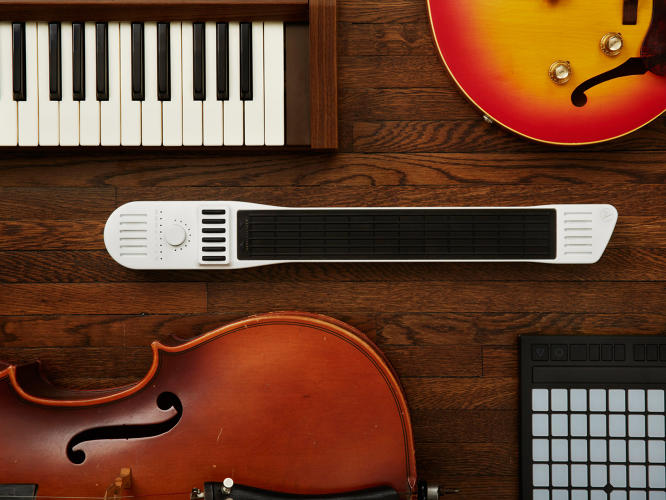Can This Weird, Crowdfunded Gadget Make Music-Making Less Intimidating?
You know how they say it takes 10,000 hours to truly master a creative skill? Mike Butera thinks that’s bullshit—at least when it comes to playing music. Butera says one of the biggest barriers to entry for regular people is the physical layout of traditional instruments. But like so many things in life, he thinks technology can free us from the rigid tyranny of black-and-white piano keys or of a six-stringed guitar—and in so doing, it might make music more accessible.
If this sounds like some kind of high-minded utopian vision from somebody at technology’s bleeding edge, well, it is. Butera is not only holds a PhD in sound studies, but he’s now a tech entrepreneur. Last year, he and cofounder Jacob Gordon launched Artiphon, a consumer hardware startup born out of the New Museum’s NEW INC incubator. After launching their first creation, the Instrument 1, on Kickstarter, they amassed $1.3 million in what turned out to be the the most successful Kickstarter campaign for a musical instrument ever. And now, it’s finally ready to ship.
The Instrument 1 is an attempt at creating a musical instrument that adapts to its player’s needs. It isn’t just strummed, tapped, or played horizontally like a piano; It is played in all of these ways and more. Its interface, which kind of resembles a shortened, rubberized guitar neck, can be played like a guitar when you’re holding it like one. Or you can bow it like a violin on your neck. Or you can play it in your lap like a piano. The result is a sort of universal instrument, untethered to the conventions of more familiar-looking music-making devices.
“Where we’re headed is toward instruments that change their gestalt, depending on how you want to use it,” says Butera. “Whether it’s actually shapeshifting or adapting to your expectations in other ways.” While future advances in material science may enable interfaces that physically change before our eyes, Butera and Gordon are happy to take an early crack at the concept with a hunk of plastic, rubber, and electronics.

The Instrument 1 plugs into your phone or computer, where it can be paired with music-making apps like GarageBand or many of the various virtual synthesizers and other software-based instruments that developers have built. Like MIDI keyboards and other controller devices, the Instrument 1 provides a physical interface for music apps so your mobile music-making isn’t limited to tapping on a glass screen. But unlike existing devices, the Instrument 1 can be played in a variety of ways. That makes it a really nice supplement to GarageBand, which features a wide range of virtual instruments like guitars, drums, synthesizers and even a new package of traditional Eastern instruments.
Since the Instrument 1 supports the MIDI standard, it works with a variety of mobile music apps, such as the recently released Model 16 modular synthesizer app from Moog. “Now I can use a violin technique to control a modular synthesizer,” boasts Butera. “That’s never been done before.”
Thanks to this interoperability, the Instrument 1 can easily go beyond the amateur musicians that Artiphon is hoping to entice and allow professionals to work a new piece of hardware into their music production repertoire. The company is already working with some well-known musicians (Beyonce’s tour manager reportedly pre-ordered one on Kickstarter), but they’re shy about rattling off names. They say that’s because they want to avoid the appearance of professional endorsements, lest they discourage the more casual musicians they’re aiming for.
Whether or not the Instrument 1 will have the effect of democratizing music as Butera envisions is up for some debate. At first glance, it’s not immediately obvious how to play it—certainly not as obvious as the horizontal row of black and white piano keys that has been with us since the 1700s. But after a quick onboarding—or perhaps just some playing around—it’s pretty easy to start making musical sounds with the Instrument 1. And if you don’t normally play music, the device lets you restrict its notes to certain harmonic keys to make you sound more proficient than you really are.
Undoubtedly, some pro musicians will flock to this device, which was named one of the best inventions of 2015 by Time magazine. Eventually, Artiphon may work those artists into its marketing, but for now, they’re prefer to use the Instrument 1 as a means of making music-playing more casual and less of an intimidating feat for everyday people.
“Mastery has never really existed,” says Butera. “It’s been this cultural construct that’s been based on the technologies at hand. Instead, we should look at what people actually want to do and how quickly we can tie technologies to the techniques that they want to use. Just bridging that kind of collapses that notion of mastery being out there in the distance. It’s right here.”
The Instrument 1 will ship out to its Kickstarter backers at the end of May. Shipments to the general public, who can now pre-order the device online, will begin in July. The device will be featured in the MoMA Design Store in New York City this summer. Naturally, Butera and Gordon already have their eye on the future.
“Our next step is taking this hardware and making software that makes it easier and easier to make music with it,” says Butera. “If you have a musical intention, how fast can you get there?”




Fast Company , Read Full Story
(22)














